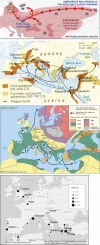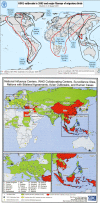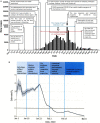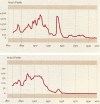Pandemics: past, present, future: That is like choosing between cholera and plague
- PMID: 33244837
- PMCID: PMC7753327
- DOI: 10.1111/apm.13098
Pandemics: past, present, future: That is like choosing between cholera and plague
Abstract
The major epidemic and pandemic diseases that have bothered humans since the Neolithic Age and Bronze Age are surveyed. Many of these pandemics are zoonotic infections, and the mathematical modeling of such infections is illustrated. Plague, cholera, syphilis, influenza, SARS, MERS, COVID-19, and new potential epidemic and pandemic infections and their consequences are described and the background for the spread of acute and chronic infections and the transition to endemic infections is discussed. The way we can prevent and fight pandemics is illustrated from the old and new well-known pandemics. Surprisingly, the political reactions through different periods have not changed much during the centuries.
Keywords: COVID-19; MERS; Pandemics; SARS; cholera; epidemics; influenza; plague.
© 2020 The Authors. APMIS published by John Wiley & Sons Ltd on behalf of Scandinavian Societies for Medical Microbiology and Pathology.
Figures












Similar articles
-
Surgeons, plague, and leadership: A historical mantle to carry forward.Am J Surg. 2020 Aug;220(2):298-299. doi: 10.1016/j.amjsurg.2020.04.042. Epub 2020 May 5. Am J Surg. 2020. PMID: 32386712 Free PMC article.
-
A historico-medical perspective on ancient epidemics and their impact on past human societies.J Prev Med Hyg. 2024 Oct 31;65(3):E456-E463. doi: 10.15167/2421-4248/jpmh2024.65.3.3383. eCollection 2024 Sep. J Prev Med Hyg. 2024. PMID: 39758761 Free PMC article.
-
Learning from the past in the COVID-19 era: rediscovery of quarantine, previous pandemics, origin of hospitals and national healthcare systems, and ethics in medicine.Postgrad Med J. 2020 Oct;96(1140):633-638. doi: 10.1136/postgradmedj-2020-138370. Epub 2020 Sep 9. Postgrad Med J. 2020. PMID: 32907877 Free PMC article.
-
Reflections on crisis burials related to past plague epidemics.Clin Microbiol Infect. 2012 Mar;18(3):218-23. doi: 10.1111/j.1469-0691.2012.03787.x. Clin Microbiol Infect. 2012. PMID: 22369154 Review.
-
Pandemic COVID-19 Joins History's Pandemic Legion.mBio. 2020 May 29;11(3):e00812-20. doi: 10.1128/mBio.00812-20. mBio. 2020. PMID: 32471830 Free PMC article. Review.
Cited by
-
Future pandemics: how can we be ready?Turk J Med Sci. 2022 Aug;52(4):1400-1403. doi: 10.55730/1300-0144.5447. Epub 2022 Aug 10. Turk J Med Sci. 2022. PMID: 36326388 Free PMC article. No abstract available.
-
Kinetics of inactivation of bacteria responsible for infections in hospitals using UV-LED.Heliyon. 2024 May 4;10(10):e30738. doi: 10.1016/j.heliyon.2024.e30738. eCollection 2024 May 30. Heliyon. 2024. PMID: 38765034 Free PMC article.
-
The Influence of the COVID-19 Pandemic on the Sexual Lives of Polish Young Adults.J Clin Med. 2024 Jun 7;13(12):3370. doi: 10.3390/jcm13123370. J Clin Med. 2024. PMID: 38929899 Free PMC article.
-
High Glucose Reduces Influenza and Parainfluenza Virus Productivity by Altering Glycolytic Pattern in A549 Cells.Int J Mol Sci. 2025 Mar 25;26(7):2975. doi: 10.3390/ijms26072975. Int J Mol Sci. 2025. PMID: 40243606 Free PMC article.
-
Microbial ecology and evolution is key to pandemics: using the coronavirus model to mitigate future public health challenges.Heliyon. 2022 May;8(5):e09449. doi: 10.1016/j.heliyon.2022.e09449. Epub 2022 May 18. Heliyon. 2022. PMID: 35601228 Free PMC article. Review.
References
-
- Morabia A. Epidemic and population pattern in the Chinese Empire (243 B.C.E. to 1911 C.E.): quantitative analysis of a unique but neglected epidemic catalogue. Epidemiol Infect 2009;137:1361–8. - PubMed
-
- Gjedde A. Peter Ludvig Panums videnskabelige indsats. Copenhagen, Denmark: Costers Bogtrykkeri, 1971: 256.
-
- Muscat M, Bang H, Wohlfahrt J, Gliesmann S, Mølbak K. Measles in Europe: an epidemiological assessment. Lancet 2009;373:383–9. - PubMed
-
- Clark T. Changing pertussis epidemiology: everything old is new again. J Infect Dis 2014;209:978–81. - PubMed
-
- Nørskov‐Lauritsen N. Et paradigmeskifte. Bibl Læg 2016;208:304–23.
Publication types
MeSH terms
LinkOut - more resources
Full Text Sources
Other Literature Sources
Miscellaneous

